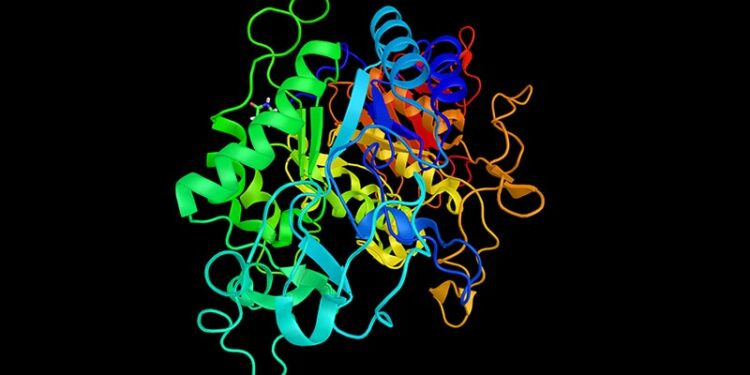Researchers from Canada and the United States have created an artificial intelligence (AI) tool called PepMLM to target “undruggable” disease proteins. This development could lead to new treatments for previously untreatable cancers, hormonal disorders, Huntington’s disease, and viral infections.
PepMLM uses a natural language processing technique called masked language modeling (MLM) to understand the “language” of proteins. Instead of focusing on a protein’s structure, PepMLM uses information about a protein’s sequencing to develop druglike molecules that can break down proteins with unknown or unstable structures.
“Traditional methods to generate peptides to bind to proteins could take years of work and millions of dollars because we assumed knowing the structure of the target was critical,” study author Ray Truant, PhD, professor of biochemistry and biomedical sciences at McMaster University in Hamilton, Ontario, told Medscape Medical News.

“What PepMLM demonstrates is that we don’t need to know structure, just sequence, which is in many databases for almost all proteins in every human cell, as well as bacterial and viral proteins,” he said. “This speeds up development time and reduces costs dramatically.”
The study was published online August 13 in Nature Biotechnology.
Developing PepMLM
The multidisciplinary research team has developed numerous models to design peptide-guided protein degraders, which typically relied on existing partner sequences to provide scaffolds for peptide design. Their recent model PepPrCLIP creates new peptides after sampling for peptide candidates and determining target sequence specificity.
As a next step, Truant and colleagues designed PepMLM as a purely de novo, target-sequence-conditioned binder design algorithm, building on the foundations of ESM-2, a protein language model developed by Meta AI.
By using a masking strategy that puts the peptide binder sequence at the end of the target protein sequences, PepMLM compels ESM-2 to completely reconstruct the entire binding region. During testing, PepMLM matched or improved on validated peptide-protein sequence pairs, outperformed current state-of-the-art models for peptide binder design, and exhibited specific binding to disease-relevant targets.
In initial experiments, the research team found that PepMLM could create strong and specific peptide binders for neural cell adhesion molecule 1, which is a key marker for acute myeloid leukemia, and anti-Müllerian hormone type 2 receptor, which is a critical regulator of polycystic ovarian syndrome.
In further experiments, PepMLM-designed peptides could potentially address Huntington’s disease by degrading disease-related proteins such as MSH3 and the mutant huntingtin protein.
In addition, PepMLM peptides significantly reduced viral phosphoprotein levels from two emerging viruses that the researchers selected for “high pandemic potential” — the Nipah virus and the Hendra virus — as well as the endemic virus human metapneumovirus. The three viruses have few or no vaccines or antiviral treatments.
“The take-home message is that the algorithm can allow any input protein text sequence to generate a binding peptide,” Truant said. “We can target any protein — or tiny part of a protein. It will be a new universal tool for drug development.”
Uncovering Peptide Potential
Molecular geneticists and biomedical scientists have developed numerous algorithms in recent years to identify peptide binding sites and target them for practical application. Researchers at the University of Toronto, for instance, developed PepNN-Struct and PepNN-Seq to predict peptide binding sites based on protein structures or sequences. PepMLM uses training data from PepNN and Propedia.
In 2024, the University of Toronto team also developed a deep-learning model called PepFlow to predict peptide structures, offering another method for better therapeutic delivery.
“Peptides are important biological molecules and are naturally dynamic, so we need to model their different conformations to understand their function,” said Philip M. Kim, PhD, professor of molecular genetics and computer science at the University of Toronto. Kim, who codeveloped PepFlow and the PepNN models, serves as a Canada Research Chair in machine learning in protein and peptide science.

“Peptides are also important as therapeutics, as can be seen by the glucagon-like peptide-1 analogues, like Ozempic, used to treat diabetes and obesity,” he said.
These deep-learning models still have numerous limitations and room to grow, Kim noted, yet they have exciting potential for future treatments. PepMLM researchers, for instance, have established biotechnology companies to develop more advanced models and use the technology for various applications and diseases.
“I took note of PepMLM when it came out in a preprint [publication] about two years ago. It’s an interesting approach and can be seen in some ways as complementary to purely structure-based approaches,” Kim said. “A key point currently in biomedical machine learning is whether the best models can generalize or whether they only interpolate from their training data. This is a question here for future investigation (and indeed, also for other peptide design methods), though interpolation itself can also be quite useful.”
The study was funded by grants from Duke University, Cornell University, the CHDI Foundation, the Wallace H. Coulter Foundation, the Hartwell Foundation, the Krembil Foundation, and the National Institutes of Health. Truant reported no relevant financial relationships. Kim is a cofounder of and consultant to multiple companies, including Fable Therapeutics, TBG Therapeutics, and Zymedi.
Carolyn Crist is a health and medical journalist who reports on the latest studies for Medscape, MDedge, and WebMD.
Source link : https://www.medscape.com/viewarticle/new-ai-tool-can-target-previously-untreatable-diseases-2025a1000ma1?src=rss
Author :
Publish date : 2025-08-22 18:04:00
Copyright for syndicated content belongs to the linked Source.




